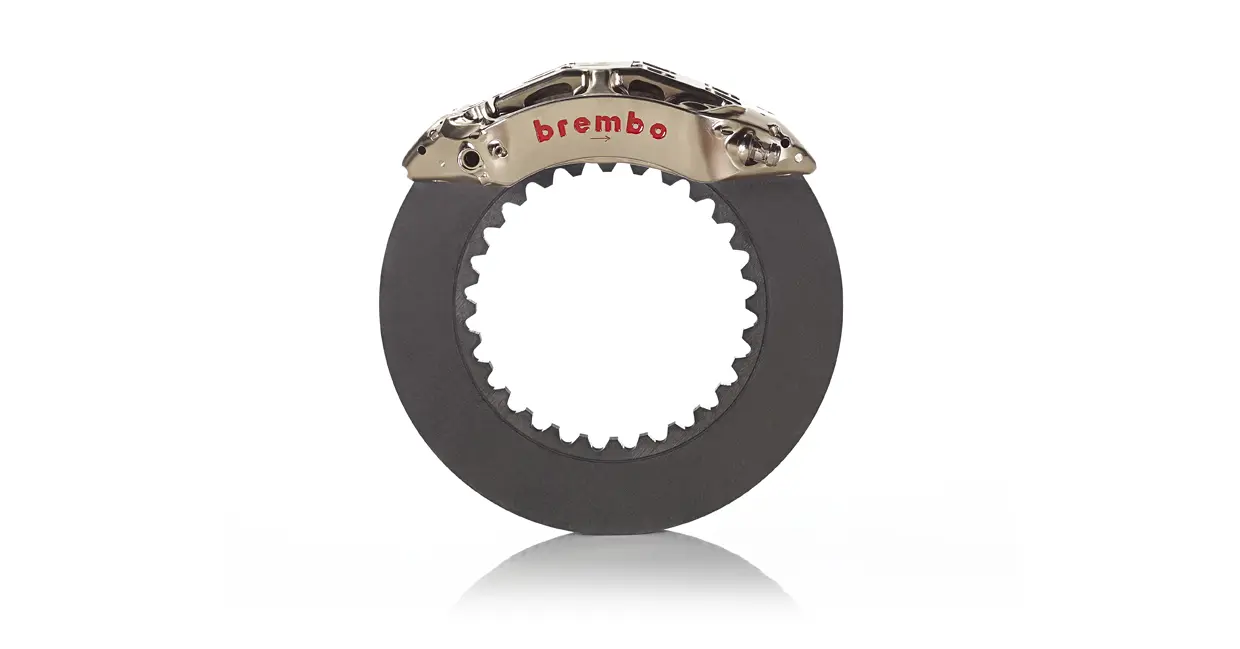
17 July 2020
All the latest news from Brembo for the f1 season
The latest developments for Brembo braking systems which will be competing in the F1 championship.
Brembo reconfirms its commitment to the Formula 1 World Championship which started off with the Austrian GP.
Thanks to the experience accumulated in 45 Formula 1 seasons, Brembo has designed braking systems personalised for each team.
Thanks to the experience accumulated in 45 Formula 1 seasons, Brembo has designed braking systems personalised for each team.

Six carbon disc solutions
The single-seaters’ aerodynamic set-up defined for 2020 is not very different from the one devised for last season, yet it does feature improved engine performance levels, which translate to an increase in vehicle peak speed entailing longer braking efforts.
The majority of the single-seater cars will use front carbon discs with 32 mm thickness and 28 mm-thick rear discs. Depending on the temperatures expected during a Grand Prix and the specific race strategy, each driver can choose between six different options of disc solutions for the front and two different disc variants for the rear.
While in 2019 Brembo offered racing teams three different front disc variants (1480 holes - Very High Cooling - arranged on 7 rows as the most extreme solution; 1250 holes - High Cooling - arranged on 6 rows; 800 holes - Medium Cooling - arranged on 4 rows), these three different ventilation specifications are confirmed in 2020, but each specification is also presented with a process on the external diameter, that is called a “groove”.
The new family of discs with "groove" is characterised by processing on the outer diameter of the disc which creates a section diverging from the air and which in turn comes out of the disc's ventilation holes. This geometry allows for greater material cooling efficiency.
Specifically, the solution of 7 rows of holes with “groove” makes it suitable for the most severe circuits for the braking system, such as Sakhir's in Bahrain, Marina Bay's in Singapore, Montreal’s in Canada and Yas Marina’s in Abu Dhabi. On tracks like these, the temperature of the discs can reach peaks of up to 1,200 degrees.
The majority of the single-seater cars will use front carbon discs with 32 mm thickness and 28 mm-thick rear discs. Depending on the temperatures expected during a Grand Prix and the specific race strategy, each driver can choose between six different options of disc solutions for the front and two different disc variants for the rear.
While in 2019 Brembo offered racing teams three different front disc variants (1480 holes - Very High Cooling - arranged on 7 rows as the most extreme solution; 1250 holes - High Cooling - arranged on 6 rows; 800 holes - Medium Cooling - arranged on 4 rows), these three different ventilation specifications are confirmed in 2020, but each specification is also presented with a process on the external diameter, that is called a “groove”.
The new family of discs with "groove" is characterised by processing on the outer diameter of the disc which creates a section diverging from the air and which in turn comes out of the disc's ventilation holes. This geometry allows for greater material cooling efficiency.
Specifically, the solution of 7 rows of holes with “groove” makes it suitable for the most severe circuits for the braking system, such as Sakhir's in Bahrain, Marina Bay's in Singapore, Montreal’s in Canada and Yas Marina’s in Abu Dhabi. On tracks like these, the temperature of the discs can reach peaks of up to 1,200 degrees.
Two disc solutions are confirmed for the rear braking system: 1250 holes (High Cooling), arranged on 5 rows; 800 holes (Medium Cooling) arranged on 3 rows.
Pursuit of lightness
Brembo continues to work on the braking system with a specific focus on the maximum miniaturisation of the elements composing the Brake by Wire system and the lightening of aluminium-lithium calipers. Brembo will supply the traditional six-piston calipers, maximum value established by the regulation, to 8 teams out of 10.
At the same time the company has tried to increase the system promptness of response and thus the reactivity of BBW units: the integration level with the cars is always greater and in 2020 there will be a generous 4 teams using Brembo Brake by Wire.
Customisation, telemetry and maintenance
According to the specific needs of the car, each team defines together with Brembo technicians the optimal ratio between weight and stiffness that the brake calipers must have. The sophisticated design methods have made it possible for each team to design a brake caliper model that has optimised the desired weight-stiffness ratio. In this situation some teams will prefer lighter but also less stiff calipers, while others will opt for more conservative solutions characterised by a greater stiffness but also greater weight. This delicate balance allows Brembo to develop the braking system for each team in a totally autonomous way.
Using the sensors, the teams know the temperature of discs and calipers at all times. Evaluating the data, technicians are able to give the driver any indications to adjust the brake balance of the single-seater: this happens when anomalies are found.
As for carbon pads, in 2020 Brembo offers the teams a choice of two different compounds.
On average, each team orders from 10 to 15 sets of Brembo calipers per year: this number makes it possible safely to face any accidents and the lack of availability of some sets for revision. Some teams, on the other hand, proceed initially with a reduced order, foreseeing a development during the season and then a subsequent order of even more optimised calipers.
The useful life of a Formula 1 caliper does not exceed 10,000 km, during which periodic revisions are scheduled and carried out directly by Brembo inside its production departments. As regards friction material, each team uses up from 150 to 300 discs and up to 600 brake pads during the season.
Using the sensors, the teams know the temperature of discs and calipers at all times. Evaluating the data, technicians are able to give the driver any indications to adjust the brake balance of the single-seater: this happens when anomalies are found.
As for carbon pads, in 2020 Brembo offers the teams a choice of two different compounds.
On average, each team orders from 10 to 15 sets of Brembo calipers per year: this number makes it possible safely to face any accidents and the lack of availability of some sets for revision. Some teams, on the other hand, proceed initially with a reduced order, foreseeing a development during the season and then a subsequent order of even more optimised calipers.
The useful life of a Formula 1 caliper does not exceed 10,000 km, during which periodic revisions are scheduled and carried out directly by Brembo inside its production departments. As regards friction material, each team uses up from 150 to 300 discs and up to 600 brake pads during the season.
